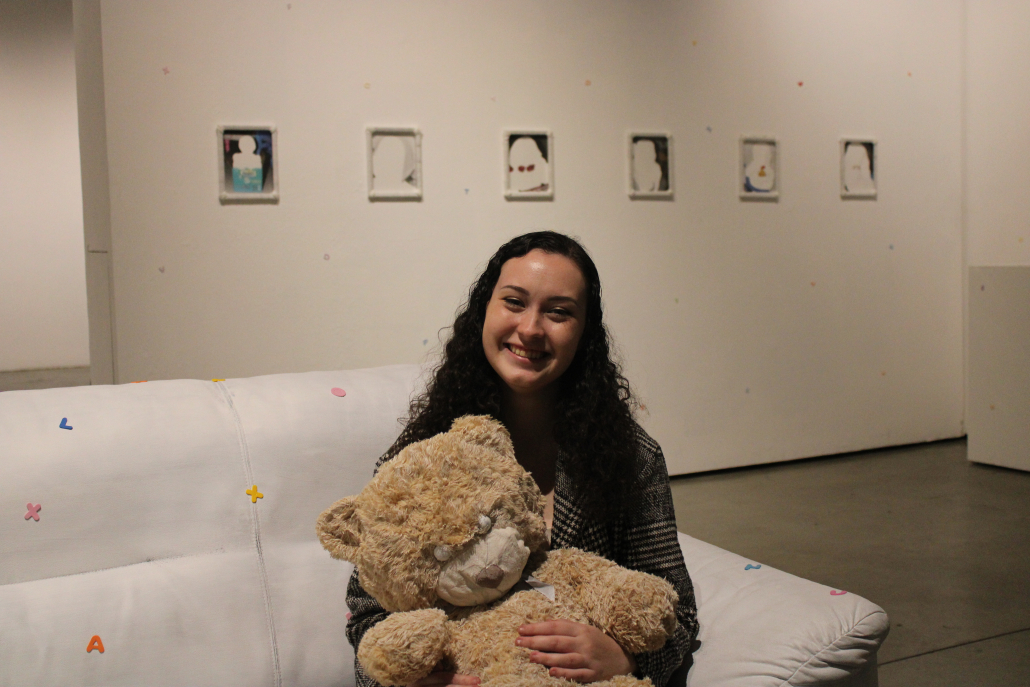Mixing the mundane with the metaphysical

(Alia Yee Noll | Daily Trojan)
After moving to Hawaii when she was six, Kim Sieberg left many of her childhood memories behind in a small apartment in Franklin, Massachusetts. But between her mom’s immaculate photo albums and nostalgic conversations with her older sister, things start to float back: a dining table, a stuffed rabbit, a box of strawberries.
In her Roski exhibition, “from what can be remembered,” Kim, a junior majoring in art, recalls her childhood home by its spatial form: White yarn wraps around old photos, with Kim’s body cut out to represent the fuzzy differences between the known and unknown. Recreations of home videos are projected onto the walls of the Fine Arts Gallery. Colorful foam letters dot the furniture, bringing a childlike wonder to the exhibition.
“from what can be remembered” started with Kim returning to Massachusetts in 2019 with her family, hoping to feel the connection she had been missing.
“I was like, ‘oh my gosh, I’m going to remember so many things and all these places are going to bring me so many memories and I’ll have like this feeling of being home,’” Kim said. “And that never really happened. I got there and was like, ‘I’ve seen a photo of this place, but it’s not how I remember it feeling.’ And I guess that kind of feeling is what I’m trying to express in my exhibition.”
Most of the concrete memories Kim does have of Massachusetts are with her sister, who is a year and a half older.
“I would basically stick around her and do whatever she was interested in,” Kim said. “She is a creative writer and I’m an artist, so what we used to do as kids was she would write these cute little books and I would do the little illustrations in them.”
While the exhibition focuses on the physical space of the apartment, Kim’s tight knit family dynamic shines through. Kim’s older sister Lauren Sieberg, a graduate student at Chapman University, echoed Kim’s experiences growing up.
“Our family tried to really cultivate the importance of story and creation and art that manifested in the form of creating these silly little stories,” Lauren said. “It was like, ‘You’re my person. You’re gonna do one thing and I’ll do the other.’ There was no other person for it … Why would I choose someone else when I have Kim?”
Lauren, who is earning master’s degrees in English and creative writing, praised Kim for opening up about her family through the exhibition.
“Truly, I am so proud of her, in part because I know it’s very hard to create things focused around topics that are so close to you and so vulnerable and personal,” Lauren said. “Oftentimes those can be the ideas that you want to just lock up tight in your chest and not show anybody, but simultaneously those ideas end up being the things that you really want to explore and work through.”
The white yarn around her photos is reminiscent of Kim’s past projects where she used a technique called punch needling — a method for embroidery that uses tight loops of yarn.
“[Punch needling] is this very repetitive process, and it’s very intentional and time consuming,” Kim said. “It makes me feel a lot of attachment towards what I’m working on, especially if it has these very powerful themes of family.”
Kim wants to mirror the love and care her family has shown her through her yarn work.
“My family has truly been there through everything, from heartbreak to falling down the stairs and injuring my knee,” Kim said. “There’s this quality to yarn where you have to work really hard to make it into a form that you want, but also there’s still this fragile nature to it that is really interesting.”
Roski Arts Photo Laboratory Technician Jon Wingo noted that the multimedia aspects of “from what can be remembered” play to Kim’s strengths.
“Kim’s a fantastic artist and she’s multidisciplinary,” Wingo said. “A lot of her illustration work is pretty awesome. You can see the back of her computer has a lot of her own design work of really cute illustrations and stickers, but also Kim’s a great photographer … When I think of her work, I think of primarily her last photographic project that she did last semester where she was doing self portraiture where she was using a mechanical camera, lighting it herself and performing in front of the camera at the same time, which is incredibly difficult.”
Kim hopes that “from what can be remembered” proves that home can be found anywhere, as long as you’re surrounded by the people you love.
“The exhibition is like this grand love letter to how I was raised, and all the sacrifices and memories and the way that I grew up,” Kim said. “Most of those memories that were made in that apartment in the end are because of my family and with my family.”
“from what can be remembered” is available for viewing until Mar. 8 at the Roski Fine Arts Gallery.

